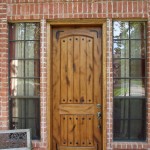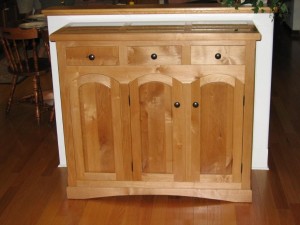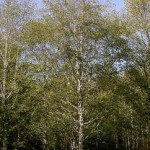Blog Home > Wood Conversations

Custom Knotty Alder Cabinets with a glaze finish
I’m going to surmise that you’ve never used alder for woodworking projects. Few woodworkers have. On a whole, they’re just too busy making beautiful things with walnut or cherry or oak to stop and consider this wood. Poor souls. It’s time to pause for a minute.
Down in the southwestern U.S. we see it often, and for good reason. It’s plentiful, easy to work with, people like the look, and – um, get ready for this one – it’s pretty, it’s cheap . . . pretty cheap.
Wait. Stop. Don’t smack your computer screen. You read that right.
I’m here to bring alder to your attention, because you just might enjoy the wood, both in cost and characteristics.

Knotty alder entry door
Custom home builders employ alder quite often for cabinetry and entry doors. What’s really cool about alder is that you can get a rustic grade with tight, sound knots that, when completed in the form of cabinets or furniture or something, has a wonderful “old Mexico” flavor without sacrificing structure. Use a little hammered iron hardware and a touch of stain to give it some authenticity, and you’ve got some incredible art.
Guitar makers actually use the wood as well. They take advantage of that light weight and use it in solid body electric guitars, yet laminate some fancy material to the top side. Alder is easy to shape so it works well for them.
Oh, You’re Not Into Knots? No Prob.
Alder is also easily sourced in a superior grade with 83% clear face — the same percentage of clear wood as commanded by the FAS grade (the highest hardwood lumber grade). This grade comes in handy for your moldings and such that need long clear sections.
Recently featured in Fine Woodworking Magazine (June 2009 issue), Alder seems to rank as a top choice among the most inexpensive hardwoods. They quote:
“Red alder has a nicer grain pattern than cherry, and its sapwood is less of a headache when it’s time to apply a finish.”
Reasonable remark, but I think that misses the real highlights of alder. It’s an even colored tan wood, nice and light – both in weight and color tone. If you like the light color of cherry before it darkens up, alder is your wood. The surface is closed up tight so the sanding and finishing processes are quick and as painless as they can be — not like, oh say, oak with its open, porous grain that needs a grain filler to get a glass-smooth surface. If your router bits, table saw blades, and chisels could talk, they’d request you use alder more often as well. It’s a breeze to work with.
Take a look at this wine cabinet by one of our talented customers, Joe Tripodi (click it to see the full size):

Wine Cabinet made of Superior Alder, by Joe Tripodi
Of course, his craftsmanship helps tug your heart strings I’m sure, but just look at that wood. Are you dreaming of your next project yet? You saying to yourself, “Hey, I want to make something like that” yet?
Specs and Data

Alder grain scan

Alder tree (Alnus rubra)

Alder leaf
Alder either appeals to you or it doesn’t.
Which means this comes down to two different schools of thought:
- The wood is great . . . it’s soft and it’s light!
- The wood is horrible . . . it’s soft and it’s light!
One man’s trash is another man’s treasure, I guess.
Hardness has an industry standard for measurement: they take a .444″ diameter stainless steel ball and embed it into the surface of the wood until it goes in to half it’s diameter. The PSI required to get it there equates to the wood’s hardness. So . . . good ol’ red oak comes out to 1290 PSI. Alder? Just a mere 590 PSI. No doubt, alder is pretty soft.
The tree is a less-than-impressive creature (compared to other hardwood trees, anyway) that reaches around 100′ tall at maturity. The alder tree limits itself in the 48 U.S. to the western coast, which is the primary reason why many woodworkers may not have ever used the wood – simple availability. If you’re lucky, really lucky, the tree will be just over 24″ in diameter, which means the boards that come from alder trees are generally narrow. Not much wider than 6″ on a consistent basis. Any wider is uncommon. 12″ wide? We’d probably call that miraculous.
Some time ago, alder wasn’t much more than just a pretty good fuel wood. It grows among hemlock and douglas fir, which used to be considered more commercially viable. So alders were often just bulldozed and discarded in favor of these other two trees. Fishermen of the Pacific Northwest know the benefit of a handy chunk of alder under a grilling fillet of fresh-caught Snake River salmon – they say cooking on a piece of alder enhances the flavor.
You can see here that, despite its softness and light weight, many craftsmen use those characteristics to their advantage and continue to make beautiful things from this wood. And you? Ever worked with Alder?
See our list of Alder lumber and wood products, with pricing, here:
https://www.woodworkerssource.com/Alder.html
Vice President of Operations – Woodworkers Source
We’re a family-owned lumber & woodworking supply retailer with 3 delightful stores in Arizona, and 35 friendly employees.
Mark oversees the company and creates tutorials on wood finishing and woodworking tips for hardwood lumber.
Woodworkers Source is a division of MacBeath Hardwood Co.
Discussion, Questions & Answers







